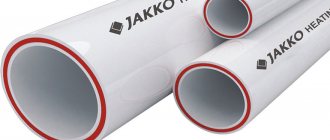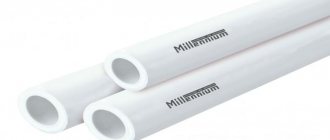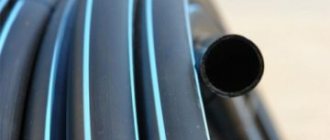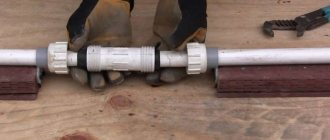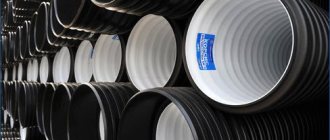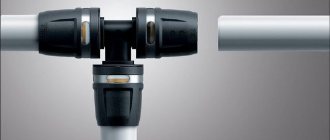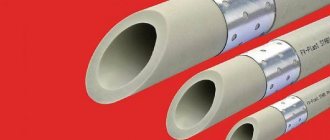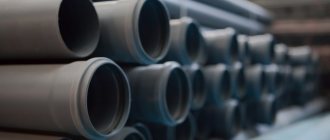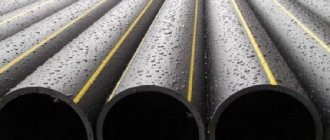Polypropylene pipes, widely used for the installation of heating systems, cold and hot water supply, as well as other engineering systems, are represented in a fairly wide range. Different types of products have different characteristics and scope of application. Therefore, when choosing pipe products, it is important to understand which polypropylene pipe is best suited for certain purposes.
Features of marking polypropylene pipes
In order to correctly select the types and characteristics of PP pipes, you need to pay attention to their markings. First of all, you need to pay attention to the designations that characterize the operating pressure and temperature of pipe products. The standardization system in force today classifies polypropylene pipes into 4 groups:
- PN10 - polypropylene pipes designed for an operating pressure of 10 atmospheres and an operating temperature of up to +45 °C. Such products have thin walls and can only be used for transporting cold liquids;
- PN16 - PP pipes, designed for operating pressure up to 16 atmospheres and operating temperature up to +60 °C. Not intended for hot water supply and heating systems;
- PN20 - polypropylene pipes designed for operating pressure up to 20 atmospheres and operating temperature up to 95 °C. They can be used in heating and hot water supply systems, however, due to significant temperature deformation, their use in these systems is limited;
- PN25 - polypropylene pipes designed for operating pressure up to 25 atmospheres and operating temperature up to 95 °C. Polypropylene pipes PN 25 are available in reinforced versions. A layer of aluminum foil or fiberglass serves as a reinforcing element. The use of an additional reinforcing layer significantly increases the strength characteristics and reduces thermal deformation. Thanks to this, reinforced pipes for heating and hot water supply are optimally suited.
Popular manufacturers
Brands of pipes and fittings popular today on the Russian market:
- Valtec (Italy) presents three categories of polypropylene pipes: thin-walled, foil-reinforced (99.4% aluminum), fiberglass-reinforced. Material – PP-R 100. The layers are glued with adhesive compositions made in Japan and America, providing a layer strength of 70 N per 10 mm (standard – 15). During the welding process, a bead of straightened plastic does not form. A special feature of the fittings is a conical socket. Parts with metal threads are octagonal (due to their shape, they can be worked with standard keys).
- Banninger (Germany). The raw material is chemically neutral polypropylene random copolymer. The products can also be used to supply drinking water. The main disadvantage of the brand is the high price.
- Wavin Ecoplastic (Czech Republic). The pipes can withstand loads of up to 20 atm. Types of heating pipes: Stabi - foil reinforced, Fiber, Basalt+ - basalt fiber. The remaining models are suitable for cold water supply.
- Kalde (Türkiye). Types: pure polypropylene – PN10 and 16; glass fiber reinforced – PN16; superpipe – reinforced with perforated aluminum foil. The latter type does not require stripping and facing when welding. Service life at temperatures up to 70 degrees is 50 years.
- Tebo (Türkiye). The raw material is a durable polymer of the new generation Random Copolymer (PPR of the third type). Products have certificates for compliance with DIN, GOST, TSE standards. Section sizes are from 2 to 16 cm, types of pipes are PN10, 20 and 25. The foil in PN25 is non-perforated; stripping is required during welding.
- SPK (Türkiye). Polypropylene pipes are on average half the price of European brands, while maintaining high quality. Manufactured from Dutch raw materials using German equipment. Excellent characteristics: the products can also be used in difficult operating conditions (for example, in Siberia).
Advantages and disadvantages of polypropylene pipes
When installing heating systems, the question often arises which pipes are better: polypropylene, metal-plastic or metal. To decide on this issue, it is important to take into account all the advantages and disadvantages, as well as the characteristics of polypropylene pipes.
The main advantages of reinforced polypropylene pipes are their following features:
high durability. When used as part of heating systems, the service life reaches 50 years;- The smooth surface of the pipes prevents the formation of deposits. Thanks to this, the original bore diameter of the pipeline is maintained throughout its service life;
- high level of sound insulation. Even with significant pressure, the polypropylene pipe does not emit noise from the transported liquid;
- the low thermal conductivity of the material significantly reduces heat loss and prevents the formation of condensation, and also significantly reduces the risk of water freezing in the pipeline in winter;
- light weight. Polypropylene pipes weigh 9 times less compared to metal ones;
- high degree of chemical resistance, no corrosion;
- simplicity and high speed of installation, provided it is carried out professionally;
- no need for painting or additional maintenance during operation;
- favorable price of PPR pipes reinforced with glass fiber.
It is also necessary to consider the disadvantages characteristic of pipes made of this material. The main disadvantage for heating systems is, of course, the high value of the linear expansion coefficient. This can lead to deformation of the pipelines and their release from the fastenings, which is often accompanied by depressurization at the joints and causes leaks. In this regard, it is recommended to use reinforced PP pipes, whose coefficient of thermal expansion is significantly lower. However, reinforcement does not completely eliminate temperature deformation, so the installation technology involves installing fastening points and compensators at certain intervals.
Another disadvantage is that polypropylene pipes are not subject to deformation during installation. Therefore, special fittings must be used to make turns. In addition, when performing installation work and placing pipelines, it is important to take into account the negative effects of solar radiation, which can cause accelerated aging of the material.
In general, we can say that the ratio of advantages and disadvantages of polypropylene pipes determines their high efficiency when used as part of heating systems, as well as in other utility networks.
How elements are connected to each other
PPR pipes reinforced with glass fiber can be joined into a single structure by diffusion welding or fittings (adapters, couplings, tees and other parts).
Each method uses a special soldering iron, the so-called welding machine. The risers joined in this way create a monolithic, non-demountable structure.
The presence of special adapters in the form of threaded or flanged connections makes it possible to fasten a PPR polypropylene pipe reinforced with glass fiber to a metal line corresponding to the fittings.
Features of choosing polypropylene pipes
When choosing polypropylene pipes, four main parameters must be taken into account:
- maximum operating temperature;
- maximum working pressure;
- diameter;
- linear expansion coefficient.
The values of these parameters must be correlated with the purpose and operating conditions of the pipelines being installed.
The maximum operating temperature determines the possibility of using pipes of a certain brand to complete engineering systems for a specific purpose. Thus, pipes PN10 and PN16 can only be used for transporting cold water. PN20 products can be used for hot water supply systems, while PN25 pipes are best suited for heating.
For domestic systems, pipes with almost any operating pressure can be used. However, the value of this parameter, especially in combination with temperature, directly determines the service life of the products. That is why, for operation as part of a heating system, it is necessary to select pipes designed for the highest operating pressure.
The diameter of a polypropylene pipe determines its throughput, which makes it possible to use it in certain conditions. For example, a 32 mm or 40 mm polypropylene pipe is used for installing risers. Internal wiring is used using a 20 mm polypropylene pipe. 25 mm polypropylene pipes can also be used for the same purpose.
The coefficient of linear expansion is an important parameter that determines the degree of change in the geometry of the product under the influence of high temperature. Depending on this coefficient, the possibility of using pipes for heating or hot water supply, as well as the method of their installation, is determined. Thus, PN20 pipes have a higher coefficient of linear expansion, so they are not allowed to be laid in a closed way. Deformation of the pipe when heated can lead to destruction of the plaster. With the open installation method, more frequent installation of fasteners and compensators is required. Reinforced polypropylene pipes PN25 have a much lower coefficient of linear expansion, which allows them to be installed both inside and outside walls.
general characteristics
Pipes reinforced with glass fiber create serious competition with analogues reinforced with aluminum foil. Such risers are characterized by a three-layer structure: polypropylene - fiberglass - polypropylene. The reinforcing layer is also made from propylene, reinforced with fiberglass - glass fibers. In terms of its technical parameters, the adhesion of plastic to glass fibers can be compared to the strength of a monolith.
Glass fiber reinforced pipes are characterized by the following marking: PPR-FB-PPR.
If we compare risers with aluminum and fiberglass frames, the first option has one significant advantage: the products have greater rigidity. This means that when installing systems 1.5 meters long or more, such risers must be secured to the walls with special fasteners. Otherwise, sagging, deformation, and failure of the structure are possible.
Regarding diameters, it should be noted that products can be produced with diameters from 20 mm to 110 mm. It is these risers that can be found on sale more often than others. Although, for example, elements with a diameter of 17 mm or less are used to install heated floors.
Products of small diameters are secured with plastic clips, and large ones with clamps.
Range of polypropylene pipes
Depending on the composition of the material, the following types of polypropylene pipes are distinguished:
- PPH is a hard plastic homopolymer of polypropylene. It is characterized by poor resistance to high temperatures, therefore it is used exclusively in cold water networks, in ventilation and air conditioning systems;
- PPB is a complex block copolymer of polypropylene and polyethylene. It is highly elastic and has sufficient temperature resistance. Thanks to this, PPB pipes can be used for installing heated floors. They are also used in water supply networks, ventilation systems, industrial pipelines;
- PPR (PPCR) is a random copolymer of polypropylene, the molecular chain of which contains ethylene molecules. Pipes made of this material can be used as part of hot water supply and heating systems at a maximum coolant temperature of up to 70 °C.
- PPs. Fire-resistant polypropylene homopolymer. The most suitable material for the production of heating system pipes. Withstands operating temperatures up to 95 °C.
Areas of application
PPR tubes with a reinforcing layer are used for different purposes:
- assemblies of hot water supply pipelines;
- manufacturing of floor heating systems;
- heating circuit assemblies;
- production of industrial highways for transporting food liquids and aggressive substances.
It is better to avoid using PPR pipeline elements in cold regions, since the technical characteristics of the polymer deteriorate with temperature changes.
Color of polypropylene pipes
Polypropylene pipes can be produced in four color options: white, gray, black, green. The color depends on the composition and properties of the pipe products, which determines the scope of its application.
White and gray pipes are widely used for the installation of almost all utilities, including heating and water supply systems. A limitation in the use of white pipes is their low frost resistance, which does not allow their use in outdoor conditions.
As for gray pipes, they have the following advantages:
- ability to withstand significant working pressure;
- high chemical and temperature resistance;
- significant durability;
- easy installation by soldering.
Black polypropylene pipes are used for installation of sewerage and drainage systems. Thanks to the use of special additives, they have the following features:
- high resistance to aggressive substances;
- increased strength characteristics;
- UV resistance;
- long service life.
Green pipes are the cheapest type of product. They are used in private homes and cottages for irrigation systems.
Types of reinforcement
Polypropylene pipes are also reinforced, which allows minimizing thermal expansion and improving the strength characteristics of the product.
Two types of reinforcing materials are used in production:
- fiberglass;
- aluminium foil.
Aluminum reinforcement
Reinforcement with thin sheet aluminum (foil) can be done both from the inside and along the outer layer of the pipe. For such pipe products, the designation PEX/Al/PEX is accepted. The sheet can be either solid (monolithic) or perforated.
There are two options for placing the foil: in the middle of the polypropylene layer or closer to the outer surface. In the first case, during installation it is necessary to perform trimming, in which the foil inside the pipe is cut off by 3–4 mm without destroying the plastic.
When the reinforcing layer is located near the outer surface, the likelihood of interaction between the metal and the coolant is completely eliminated.
Pipe reinforced with perforated aluminum
Even purified water circulating through the pipe cannot be a completely chemically neutral substance. Almost always, in one concentration or another, it contains salts that react with the foil and destroy it. During installation, pipes require stripping, that is, removal of the top layer of plastic and reinforcement to create a reliable welded joint.
Glass fiber reinforcement
Plastic heating pipes reinforced with fiberglass are produced by coextrusion. In this case, the reinforcing layer is located in the middle.
Products made of polypropylene, reinforced with glass fiber, have low thermal conductivity and are used for assembling open heating systems.
The reinforcing material can be green, red, blue or orange. This is just a coloring pigment that is used by various manufacturers. You should focus on the strip drawn along the product, the color of which indicates its suitability for moving various media:
- red – for hot coolant;
- blue – for cold environments;
- the combination of blue and red colors indicates versatility of use.
Glass fiber reinforcement
Corrugated polypropylene pipes
A special type is corrugated polypropylene pipes. They are used to create sewerage, drainage, storm sewer, and drainage systems. Modern products of this type are designed to receive wastewater with temperatures up to 60 °C, and with short-term exposure - up to 100 °C.
Today, two-layer corrugated polypropylene pipes are produced. They have the following advantages:
- high chemical resistance;
- increased level of ring stiffness;
- excellent dielectric properties;
- maintaining high throughput throughout the entire service life;
- high resistance to abrasive wear;
- long service life.
Features of installation of polypropylene pipes
Installation of polypropylene pipes is carried out using the thermal polyfusion method. Its essence is to heat the parts to be connected using a special soldering iron to a temperature of about 260 ° C, after which they are quickly connected.
When soldering polypropylene pipes, it is very important to comply with technological requirements for heating time, which depends on the following factors:
- diameter of connected pipes;
- ambient temperature;
- welding belt width.
Heating provides the necessary plasticity of the material, which is maintained for several seconds. Therefore, it is very important to quickly fix the connection unit, while ensuring the correct location of the mating parts. It is also important to avoid excessive heat, which can cause the pipes to warp.
Optimal heating time when welding polypropylene pipes of different diameters:
- with a diameter of 20 mm: 8-9 seconds;
- with a diameter of 25 mm: 9-10 seconds;
- with a diameter of 32 mm: 10-12 seconds.
The same time is required to fix the connection. If this requirement is violated, deformation of the connection may occur, which will lead to its depressurization.
